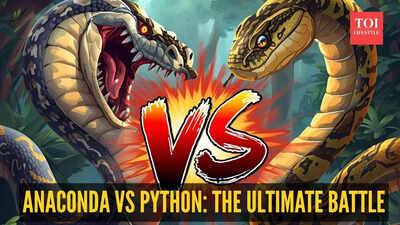ARTICLE AD BOX

Pythons and anacondas are often confused as being the same, and it’s easy to see why. Both are massive, non-venomous snakes that kill their prey by biting and squeezing it to death.
But despite their similarities, they are very different in size, strength, and habitat. So, what would happen if a python and an anaconda ever faced each other?In the wild, these snakes usually live far apart- pythons in Asia, Africa, and Australia, and anacondas in South America. But with snakes like the Burmese python appearing in new areas, a face-off between these giants isn’t completely out of the question.For this comparison, we’ll look at the reticulated python and the green anaconda, two of the biggest snakes in the world, to see which one would likely win.

Size and buildBoth snakes are enormous, but they differ in body type. Pythons can grow up to 30 feet long and weigh up to 200 pounds. Anacondas are usually shorter, around 17 to 22 feet, but much heavier, weighing 250 to 550 pounds. Their bodies are also thicker, with diameters reaching up to 12 inches, making anacondas more muscular and powerful.Speed and movementPythons are relatively slow, moving at about 1 mile per hour on land and 2–3 miles per hour in water.
Anacondas, however, are faster and more agile, capable of 5 mph on land and 10 mph in water, which gives them a clear advantage in their aquatic environment.

Squeezing power and biteBoth snakes rely on constriction to kill their prey. The python’s grip measures around 14 PSI, strong enough to suffocate medium-sized animals. The anaconda’s grip is much more powerful at 90 PSI, making it capable of overpowering much larger prey.In addition, both snakes have about 100 sharp, backward-pointing teeth, which help them hold on to their victims.
While both bites are non-venomous, the anaconda’s strength makes its bite far more dangerous in a fight.Senses and defenceBoth snakes use their tongue and Jacobson’s organ to detect chemical cues in the environment. They also sense heat, which helps them locate prey, as per a report by a(-)z(-)animals(dot)com. Pythons have poor eyesight but can detect low-frequency sounds, while anacondas can feel vibrations and sense movements even underwater.

Camouflage is key for both species. Pythons use their colour and patterns to blend into forests and grasslands, while anacondas use their eyes on top of their heads to stay hidden underwater while still watching the surroundings. Combined with their swimming skills, this makes the anaconda a stealthy predator and a difficult target.Hunting style and predatory behaviourBoth snakes are ambush predators. They lie in wait, strike suddenly, bite, and wrap around their prey until it suffocates.Pythons usually hunt on land, often at night, and can tackle medium-sized animals like pigs or deer. Anacondas hunt both on land and in water, and they often drag their prey underwater, using their immense size and strength to overpower larger animals.HabitatPythons live across a wide range of habitats in Asia, Africa, and Australia– from forests and grasslands to swamps. Anacondas, on the other hand, are primarily aquatic, living in the rivers, marshes, and swamps of South America, spending most of their lives in water where they feel most at home.Who would win in a fight?If a python and an anaconda ever fought, the anaconda would likely win. Even though pythons are longer and more flexible, they are thinner and weaker compared to the thick, muscular anaconda.

In water- the anaconda’s natural habitat- the python would be at a serious disadvantage. The anaconda’s strength, crushing power, and swimming ability would make it almost impossible for the python to escape. Over time, the python would likely be overpowered by the anaconda’s grip.On land, the python might be slightly faster and more agile, but the anaconda’s superior size and strength would still give it the edge in a close fight.Disclaimer:This article is for general information and is based on the physical traits, behaviour, and habitats of pythons and anacondas from research studies and online sources. The scenarios described, including possible face-offs between the two snakes, are hypothetical and may not happen in real life. The Times of India does not independently verify this information, and actual outcomes can vary depending on different situations and environments.Images: Canva/Canva AI (for representative purposes only)

 14 hours ago
5
14 hours ago
5









 English (US) ·
English (US) ·